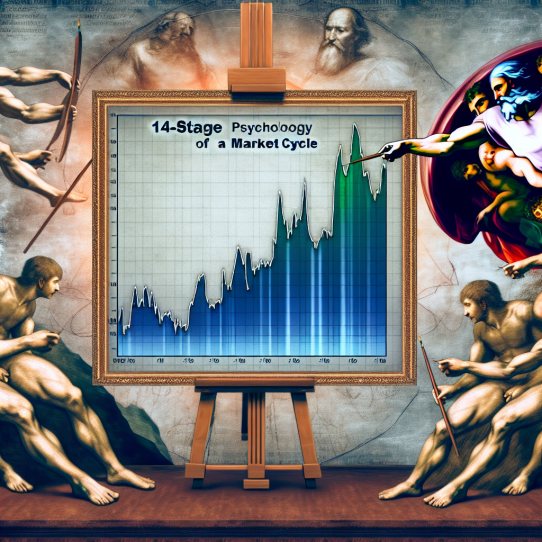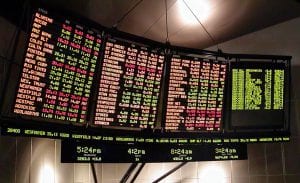
Harnessing the Psychology of a Market Cycle
April 14, 2024
Introduction
“The psychology of a market cycle is not to be underestimated,” as Herman Hesse might have mused, for it is a force that shapes the ebb and flow of financial tides. In the words of Isaac Asimov, “It is change, continuing change, inevitable change, that is the dominant factor in society today.” This sentiment rings true in investing, where the ever-shifting dynamics of market cycles demand a keen understanding of the psychological forces at play.
As we explore the psychology of a market cycle, let us heed the wisdom of Pluto, the Greek god of wealth. He reminds us that true riches lie not in the accumulation of material possessions but in the mastery of oneself and the understanding of the forces that shape our world.
Investors navigating the complexities of financial markets must recognize the emotional drivers behind each stage of the market cycle and the cognitive biases that influence their behaviour. By doing so, they can make more informed and rational investment decisions, as if guided by Pluto’s invisible hand.
Today, we will delve into the four phases of the market cycle – accumulation, markup, distribution, and markdown – and explore how the unique emotions of each stage steer investment trends. We will also examine the impact of cognitive biases on investor psychology and discuss strategies for harnessing the psychology of a market cycle to achieve long-term investment success.
As Herman Hesse once said, “Knowledge can be communicated, but not wisdom. One can find it, live it, be fortified by it, do wonders through it, but one cannot communicate and teach it.” Through the lens of this wisdom, we shall embark on our journey to unravel the mysteries of the psychology of a market cycle.
The Four Stages of the Market Cycle
1. Accumulation Stage
The accumulation stage marks the beginning of the market cycle, characterized by cautiousness and scepticism among investors. During this phase, savvy investors who have conducted thorough research and identified undervalued assets begin to make purchases. While the general sentiment may be uncertain, these investors recognize the potential for future growth and capitalize on opportunities that others may have overlooked.
2. Markup Stage
As the market transitions into the markup stage, optimism and excitement begin to take hold. Prices start to rise, and investors who missed the initial opportunity may experience the fear of missing out (FOMO). This stage is often associated with euphoria as investors witness rapid investment growth. However, it is essential to maintain a level-headed approach and avoid making impulsive decisions based solely on emotions.
3. Distribution Stage
The distribution stage signals a shift in sentiment as early investors begin to take profits, resulting in increased selling pressure. While greed may still exist as investors aim to maximize their gains, caution and scepticism resurface as the market peaks. Investors must recognize the potential for a market correction and adjust their strategies accordingly.
4. Markdown Stage
Finally, the markdown stage arrives, accompanied by feelings of fear and panic. Prices begin to decline, and latecomers to the market may experience regret and anxiety. This stage can be emotionally challenging as investors grapple with the fear of losing their investments and uncertainty about when the market will stabilize. However, contrarian investors may view this stage as an opportunity to identify undervalued assets and position themselves for future growth.
Cognitive Biases and Market Psychology
Cognitive biases play a significant role in shaping investor behaviour and market cycles. These systematic patterns of deviation from rationality can lead to irrational decision-making and amplify the emotional aspects of investing. Some common cognitive biases that impact the psychology of a market cycle include:
1. Confirmation Bias
Confirmation bias refers to investors’ tendency to seek information that supports their existing beliefs while disregarding contradictory evidence. This bias is particularly prevalent during bull markets when optimism is high. Investors may overlook potential risks and focus solely on positive news, leading to an overvaluation of assets and increased vulnerability to market corrections.
2. Herd Mentality
Mass psychology can amplify the effects of cognitive biases, particularly during the markup and markdown stages of the market cycle. As market sentiment becomes increasingly positive or negative, individuals may feel pressure to conform to the prevailing mood. This herd mentality creates feedback loops that fuel market trends, leading to excessive optimism or pessimism.
3. Loss Aversion
Loss aversion is a cognitive bias that causes investors to be more sensitive to losses than gains. This bias can lead to risk-averse behaviour, causing investors to hold onto losing positions for too long or avoid potentially profitable opportunities. Understanding the impact of loss aversion can help investors make more rational decisions and avoid the pitfalls of emotional investing.
4. Overconfidence
Overconfidence is a cognitive bias that leads investors to overestimate their abilities and the accuracy of their predictions. This bias can result in excessive risk-taking and poor decision-making, particularly during the markup stage of the market cycle. By recognizing the potential for overconfidence, investors can maintain a more balanced and objective approach to investing.
Strategies for Harnessing the Psychology of a Market Cycle
1. Conduct Thorough Research and Planning
Successful investing begins with meticulous research and strategic planning. By conducting comprehensive analysis and developing a well-defined investment strategy, investors can lay a solid foundation for navigating the psychology of a market cycle. This process involves gathering relevant information, studying financial statements, assessing industry dynamics, and understanding the competitive landscape.
2. Maintain a Long-Term Perspective
Adopting a long-term perspective is crucial for harnessing the psychology of a market cycle. By focusing on fundamental factors and long-term trends, investors can avoid being swayed by short-term market sentiment and make more informed decisions. This approach requires discipline, patience, and the ability to withstand short-term market volatility.
3. Seek Diverse Perspectives
To mitigate the impact of cognitive biases, investors should actively seek diverse perspectives and consider alternative viewpoints. By exposing themselves to various opinions and analyses, investors can gain a more comprehensive understanding of market dynamics and make more well-rounded investment decisions.
4. Embrace Contrarian Thinking
Contrarian investing strategies involve going against the prevailing market sentiment and identifying opportunities others may have overlooked. By adopting a contrarian mindset, investors can capitalize on market inefficiencies and potentially turn fear-driven losses into calculated gains. However, contrarian investing requires careful analysis, risk management, and the ability to withstand short-term market volatility.
5. Practice Emotional Discipline
Emotional discipline is essential for harnessing the psychology of a market cycle. Investors must learn to recognize and manage their emotional responses to market fluctuations. This involves setting clear investment goals, establishing a well-defined risk management strategy, and maintaining a disciplined approach to buying and selling assets.
Conclusion
Understanding the psychology of a market cycle is a critical skill for investors seeking to navigate the complexities of financial markets successfully. Individuals can make more informed and rational investment decisions by recognizing the emotional drivers behind each stage of the market cycle and the cognitive biases that influence investor behaviour.
Through thorough research and planning, maintaining a long-term perspective, seeking diverse perspectives, embracing contrarian thinking, and practising emotional discipline, investors can harness the power of market psychology to achieve their investment goals. By adopting these strategies and remaining vigilant to the ever-changing dynamics of the market, investors can position themselves for long-term success in the face of uncertainty and volatility.
Other tasty Treats
Zero Percent Mortgages Debut: Setting the Stage for Next Bull Market
Bull Bear Traders-Long Term Stock Market Bears Always Lose
Brexit’s Currency Wars: Hidden Theme for Financial Freedom
Surviving the Bear Stock Market: What’s New for Investors?
Fed Interest Rate: Negative Rates Are A Game Changer
What Economic Recovery? Most Americans Lack $1000 In Savings
Federal Reserve Interest Rate: Dangers & Benefits of Negative Rates

Why Are Interest Rates So Low: Coronavirus That’s Why
CAT Stock Price Projections And Future Trends
Why own gold in uncertain times: Protection From Disaster
HD stock quote And future price trends
Valeant Shares Slump

End Of Bull Market: Masses Worry Higher Rates Will Kill This Bull
Why Global Warming Is A Hoax & How Oil Giants Are Feeling The Heat
Nuclear Waste Management Market
From Striving to Thriving: How to Start Saving for Retirement at 50 – It’s Not Too Late


